This page contains affiliate links. Please read our disclosure for more info.
Planning a trip to Hawaii is something many people dream of. With its stunning beaches, dramatic volcanic landscapes, and lush green hills, it’s one of the most beautiful places we’ve visited but also the most expensive.
While we do think the islands are worth the high price, to make the most of your stay, it’s essential to plan in advance.
In this post, we share our top Hawaii travel tips to show you how to plan a trip to Hawaii that’s perfect for you.
We’ll cover how many days you need in Hawaii, which island to visit, where to stay, the top activities, what you must book in advance, and everything else you need to know.
Contents
- Video: Hawaii Travel Tips
- How Long to Stay in Hawaii
- Best Island to Visit in Hawaii
- Best Time to Visit Hawaii
- Planning a Trip to Hawaii: Before You Arrive
- When You Are In Hawaii
- Hawaii Tips for International Visitors
- What to Pack for Hawaii
- Is Hawaii Worth it?
- More Hawaii Posts
Maui Travel Update 2025
Since November 1, 2023, West Maui has been open for travel again (except most of Lahaina) after the devastating wildfire in Lahaina in August 2023.
Most of Lahaina will remain closed indefinitely as locals rebuild, but the Honoapi’ilani Highway through Lahaina Town has reopened. A few businesses in north Lahaina have also reopened including the Old Lahaina Luau.
Visitors to Maui are encouraged, but please be mindful and respectful of the tragedy that everyone on the island has been impacted by.
If you’d like to donate money to support Maui’s recovery, consider the Hawaii Community Foundation’s Maui Strong Fund.
Video: Hawaii Travel Tips
How Long to Stay in Hawaii
The average stay in Hawaii is about 7 days. I think this is a good minimum time for a trip, although 10-14 days is better if you want to visit multiple islands.
Some visitors do visit Hawaii for 4-5 days, but it’s a long way from the US mainland (or anywhere!) for a short trip, and you’ll spend the first few days adjusting to the time zone change. That said, if it’s all you can manage, it’s better than no time in Hawaii!
If you have a week for your Hawaii vacation, I recommend choosing just one island to visit. See below to find the best Hawaiian island for you.
If you have 10 days in Hawaii, I recommend starting with 3 days in Oahu and then visiting Maui or Kauai for a week.
Best Island to Visit in Hawaii
Choosing the best island to visit is one of the most challenging parts of planning a trip to Hawaii. They are all diverse with lots to offer, so it just depends what you are looking for.
Most visitors to Hawaii visit one of these four islands:
Oahu
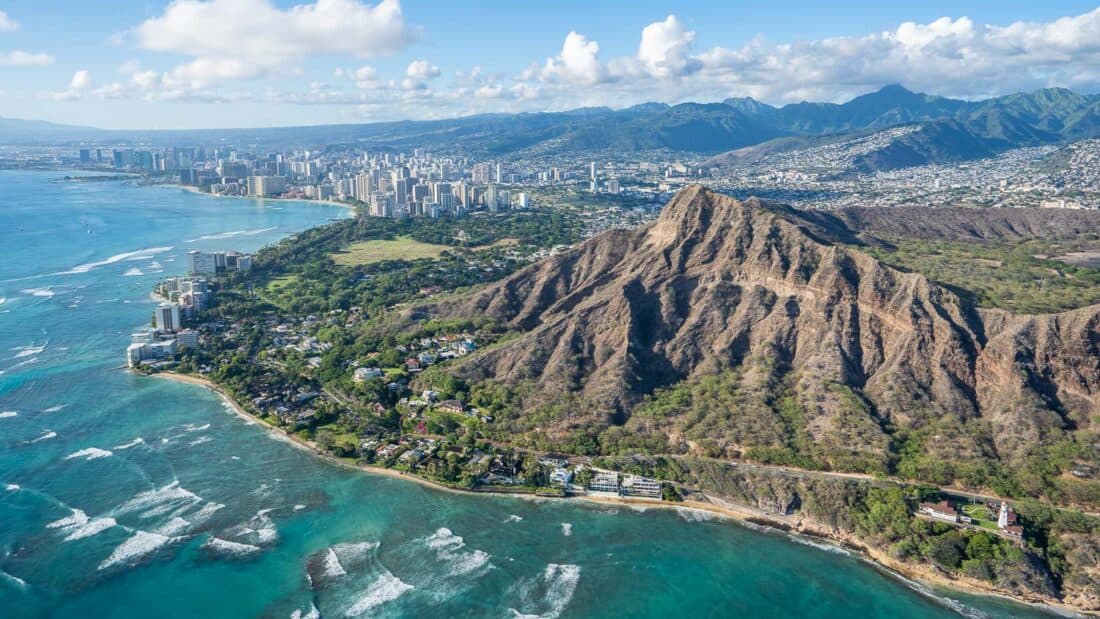
Oahu is by far the most visited and developed Hawaiian island. It’s home to the large city of Honolulu, which includes the famous and very crowded Waikiki Beach (where most visitor accommodation is located).
Oahu offers the most choice of shopping, dining, and nightlife, so if you want to combine city and beach life, this is the best island for you.
It’s also by far the easiest place to manage without renting a car (although I still recommend it). If you stay in Waikiki, you can walk to the beach and many shops, restaurants, and activities.
You can also take tours, Ubers, or the Trolley Bus to nearby attractions including the Pearl Harbour memorial.
Oahu’s North Shore offers a much more relaxed vibe with beautiful beaches and huge waves for surfing in the winter.
Oahu is easy to fit into Hawaii vacations as Honolulu International Airport offers the most flights from the mainland US and international destinations.
Our favourite activities in Oahu are:
- Taking a helicopter ride around the island for stunning views. We recommend the one hour doors off tour with Rainbow Helicopters from Honolulu.
- Snorkelling at Hanauma Bay (be sure to book).
- Relaxing on the Windward Coast beaches especially Waimānalo and Kailua.
See our 7 Day Oahu itinerary for many more tips.
Where to stay in Oahu: Turtle Bay Resort (now owned by Ritz Carlton) on the North Shore is our favourite place we’ve stayed in all of Hawaii! It is seriously dreamy with incredible ocean views, isolated beaches (with turtles!), stylish rooms, and plenty to do. It feels a world away from Waikiki.
Maui
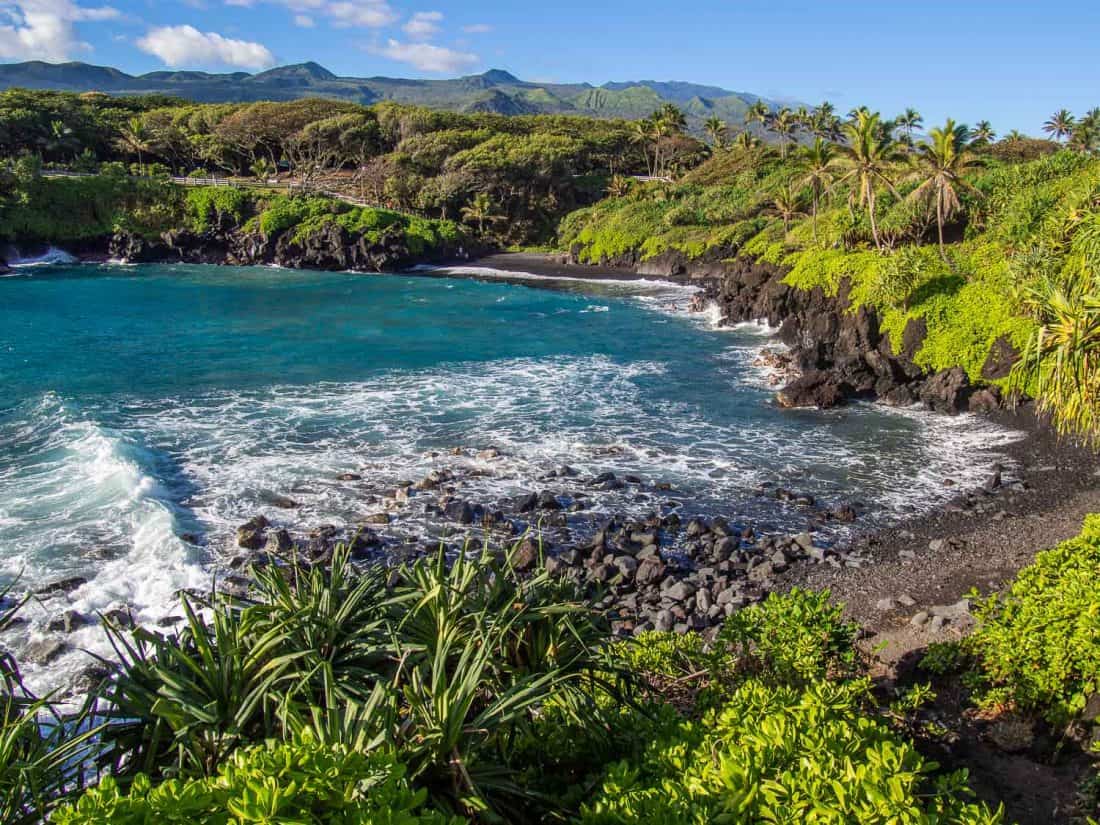
Maui is the second most visited island and is a popular honeymoon destination.
It has gorgeous beaches, world-class whale watching, and the Road to Hana drive where you can see waterfalls, bamboo forest, and black sand beaches.
You can also watch the sun rise above a volcanic crater and visit wineries and lavender farms in Upcountry.
There’s a wide range of resorts, dining, shopping, and activities as well as natural attractions.
Our favourite activities in Maui are:
- Staying overnight in Hana (we love Hana Kai Condos) to explore popular sights like Waianapanapa without the crowds.
- Whale watching from Lahaina. We saw an incredible amount of humpbacks on our small group boat trip with Makai Adventures (up and running in a new location).
- Relaxing on the beaches of West Maui (with turtle sightings!).
See our Maui itinerary for more tips.
Where to stay in Maui: Kahana Reef has affordable, oceanfront condos on the west coast. We saw whales, turtles, and incredible sunsets from our lanai.
Big Island
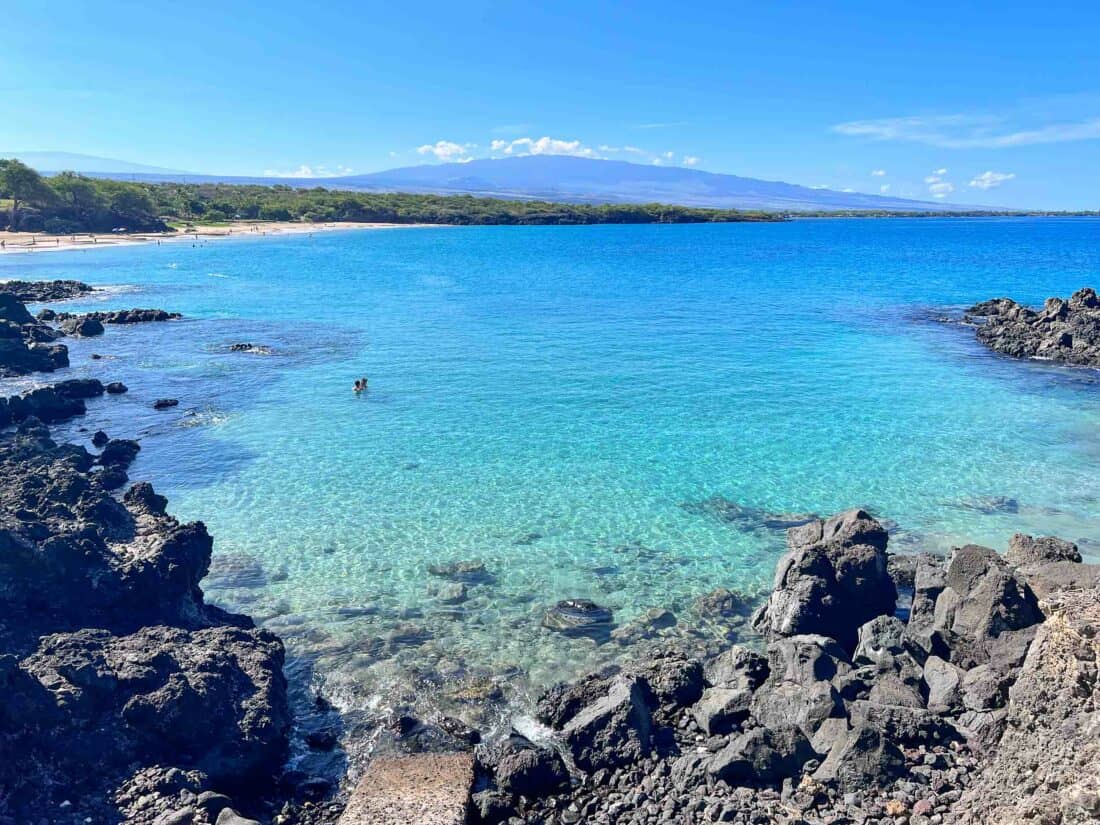
The Big Island (officially called Hawaii) is the youngest Hawaiian island, so it’s not as green as the other islands and has more lava landscapes.
If you want to see an active volcano, this is the island to visit.
It’s the largest island with diverse landscapes from white sand beaches to snow-capped volcanoes.
Our favourite activities on the Big Island are:
- Night snorkel with manta rays. We got incredibly close to these magnificent and huge creatures on our manta trip with Sea Quest.
- Snorkelling at Kealakekua Bay and Two Step.
- Kilauea Iki Trail – Hiking into a volcanic caldera in Hawaii Volcanoes National Park.
See our guide to the best things to do on the Big Island for more tips.
Where to Stay on the Big Island: You’ll want to divide your time between the west and east on this large island. Our favourite area was Volcano, where we adored this peaceful cabin in the rainforest. It’s very different from the rest of Hawaii.
Kauai
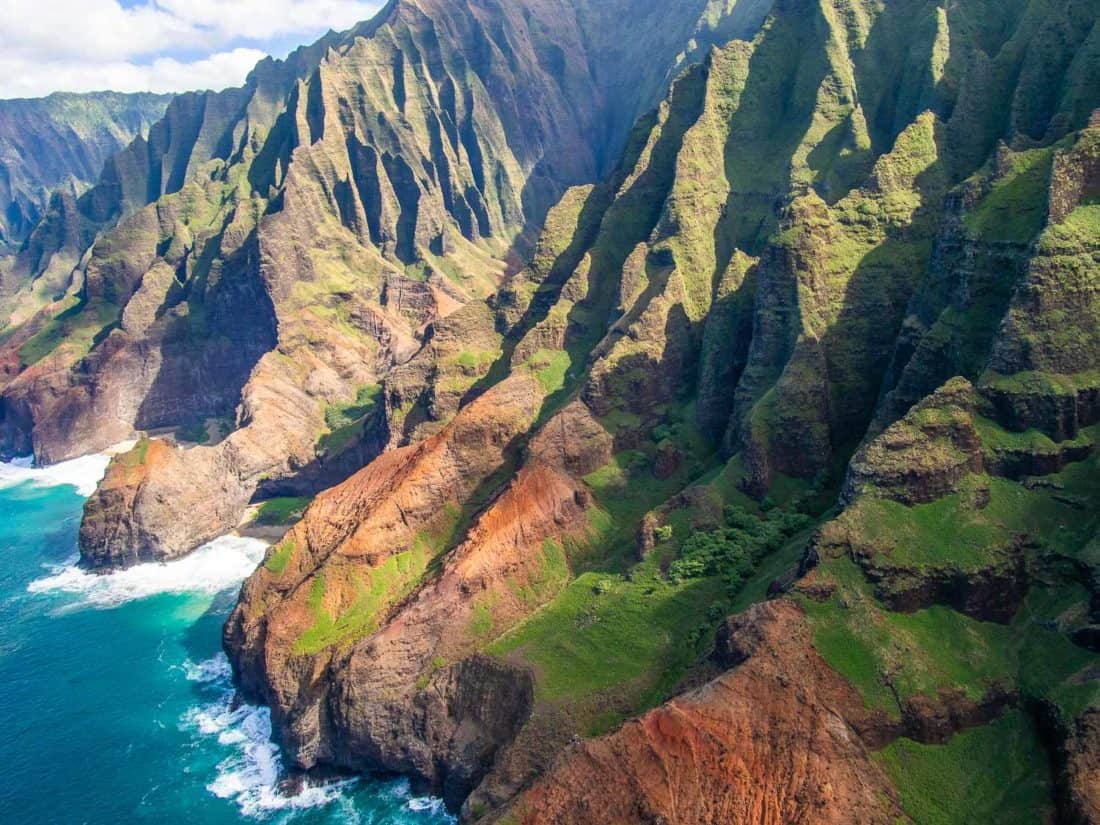
Known as The Garden Isle, Kauai is the most lush and green of the islands.
Kauai has become more popular, but it isn’t as developed as Maui or Oahu.
The jagged green cliffs of the stunning Napali Coast are the big draw, but there are also lovely beaches, waterfalls, hiking trails, and multi-coloured canyons.
Our favourite activities in Kauai are:
- Admiring Kauai from above – Our Kauai doors off helicopter ride was spectacular.
- Sailing the Napali Coast – The massive sea cliffs are stunning and we saw whales, dolphins and turtles on the way.
- Seeing turtles and seals on Poipu Beach.
See our post on the best things to do on Kauai for many more.
Where to stay in Kauai: We loved our condo at Kiahuna Plantation on a beautiful beach in Poipu.
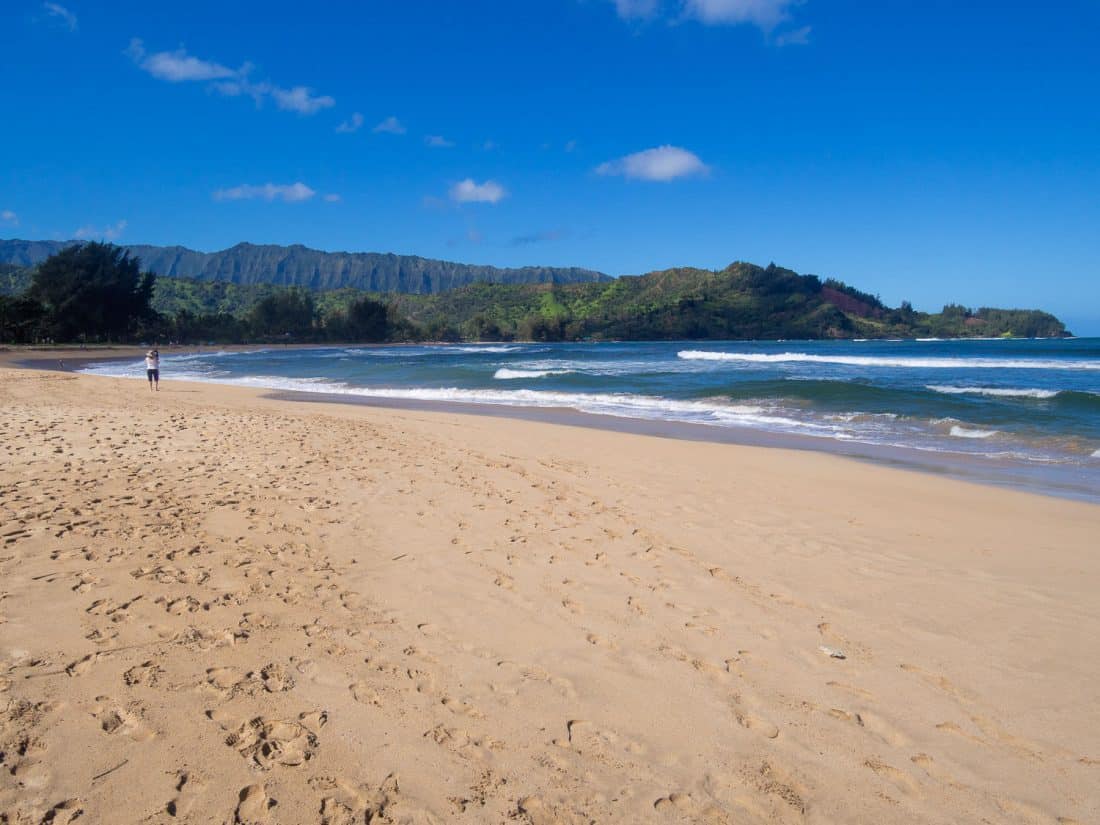
Less Visited Hawaiian Islands
If you are looking to get off the beaten track, you could consider visiting one of these smaller, much less visited islands (we haven’t made it to either yet but hope to next time):
- Molokai – Known as The Friendly Isle, on Molokai you’ll find a slow pace of life and more native Hawaiians, but less choice of accommodation and activities. It’s also home to the leper colony of Kalaupapa, which I became fascinated with after reading a couple of these Hawaii books.
- Lana’i – For many years Lana’i was a pineapple plantation and it’s now home to a few luxury resorts like the stunning Four Seasons Lana’i. If you want to enjoy the secluded beaches without the high price tag, the ferry from Lahaina on Maui only takes an hour, so you could visit on a day trip.
Which Side of the Island?
The character of each island also depends on which part you visit.
All the islands have a rainy side where the scenery is lush and green and a dry side where you’ll usually get more sun.
They are both worth visiting, which is why we split our island stays between two or three locations.
Where We Visited in Hawaii
We had 3.5 weeks on our first Hawaiian vacation (in January/February) and divided our time between Kauai and Maui, with one night in Honolulu before our onward flight.
There’s so much to do on each island that we’re glad we didn’t try to add in an extra island.
On our second 3 week Hawaii trip (in October), we spent a week on Oahu (but could have stayed longer) and two weeks on the Big Island.
We love all four of the major Hawaii islands, but our personal favourite is Kauai for the rugged green mountains and more laidback vibe.
Best Time to Visit Hawaii
There’s no bad time to visit Hawaii as it’s warm year-round, with daytime temperatures rarely dropping below 75ºF (24ºC), even in winter. Each season has its pros and cons.
To See Humpback Whales—Visit in Winter
We were astounded by how many whales we saw in Maui in February. January to March are the best months for whale watching, but you might see a few from November to May.
Winter weather in Hawaii is cooler and rainier than the rest of the year, but we still had mostly sunny days. The ocean is warm enough to swim year-round.
Winter is also the best time for serious surfers, with huge swells on the north shores (especially Oahu).
Christmas and New Year are some of the busiest times on the islands, so avoid them if you are on a budget (and book well in advance).
To Save Money—Visit in the Off-Season
In the spring (April and May) and autumn (September to mid-November), the islands are less crowded (relatively), prices are lower, and the weather is generally good. It can be very rainy on Kauai in April, though.
For Snorkelling—Visit in Summer
The summer, from June to September, is the best time for snorkelling in Hawaii. The ocean is clearer, calmer, and warmer.
The shoulder months can be good, too—we found snorkelling better in October than in February. This does vary by island.
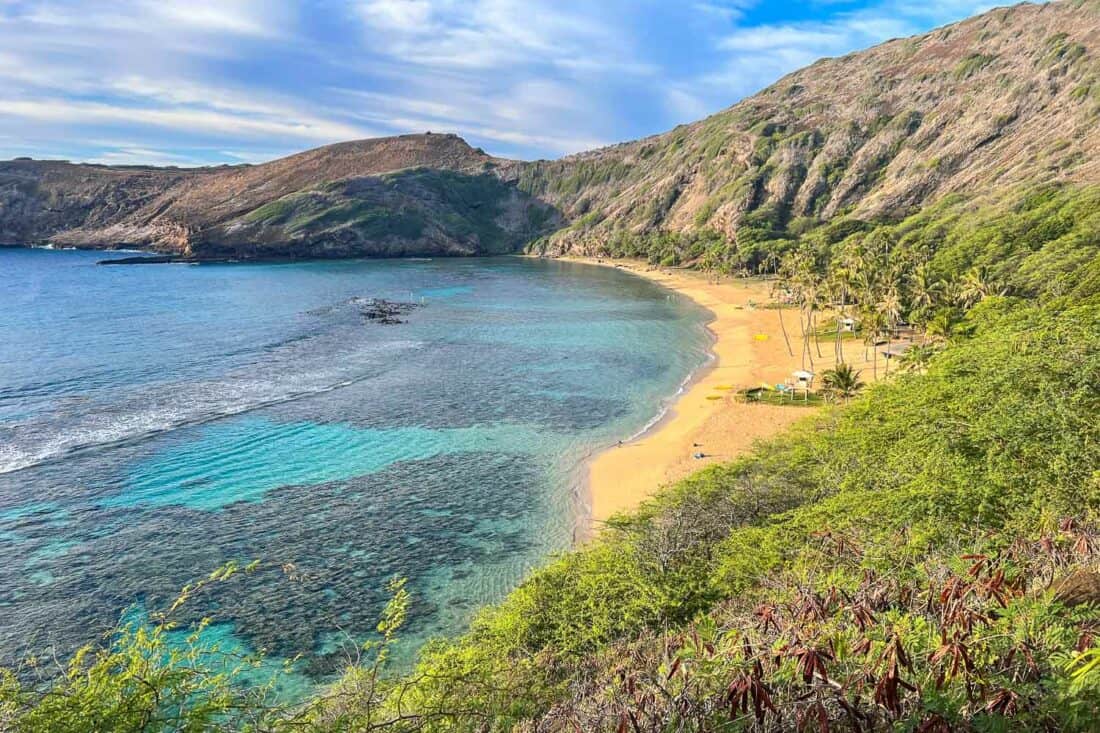
Planning a Trip to Hawaii: Before You Arrive
Do
- Save up – Hawaii is expensive and you’ll enjoy it more if you aren’t worrying about every penny. On our first trip, we spent $267 per person per day (travelling as a couple), including everything except flights from the mainland US. You could spend less by travelling in the off-season, choosing non-beachfront accommodation, and skipping pricey tours. You could also spend a lot more by staying in luxury resorts and eating out for every meal.
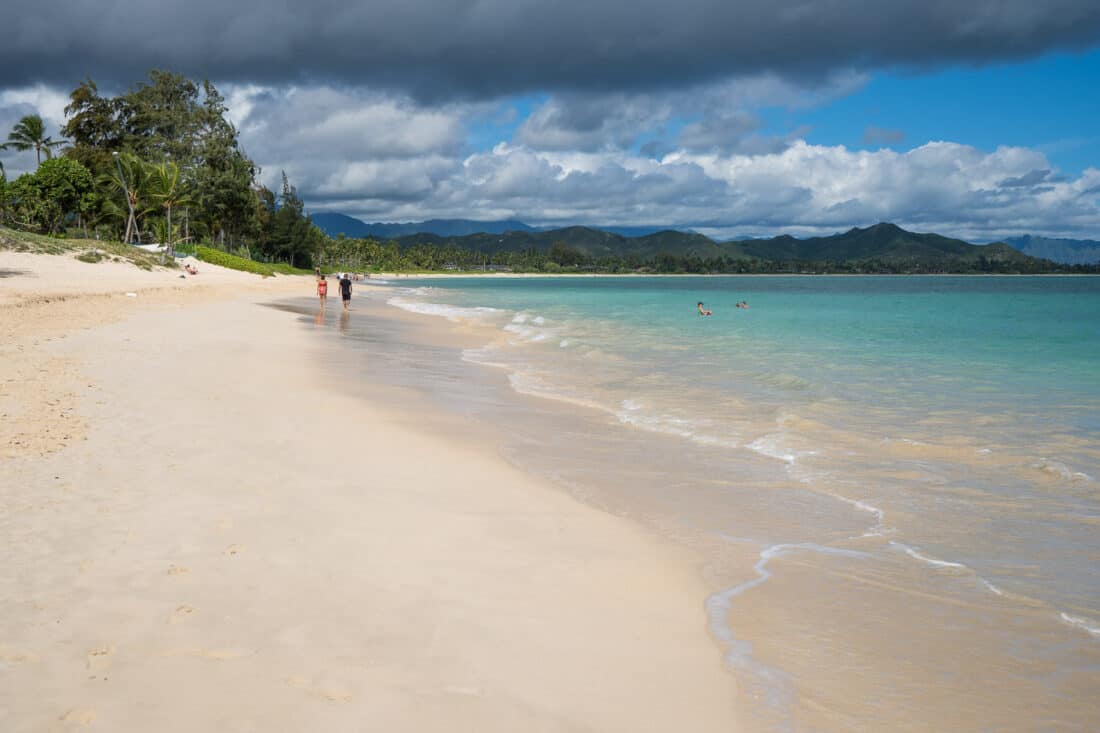
- Book your accommodation far in advance – Especially if you are travelling in the high season, want an ocean view, or are travelling to places like Hana or Upcountry on Maui where accommodation is limited. You can search for resorts and hotels on Booking and vacation rentals on Vrbo.
- Consider a condo rather than a resort – For families, stays of a week or more, and for those on a budget, renting a condo with a kitchen is a great way to save money. There are many to choose from and some have resort facilities like pools and beachfront locations. We mostly stay in condos and Kiahuna Plantation on Poipu Beach in Kauai is one of our favourites. Vrbo is a great way to find condos.
- Split your stay – If you want the classic Hawaiian resort experience but can’t afford it for your whole trip, divide your time between a condo and a resort. We did this in Oahu—staying in a condo in Waikiki for 4 nights while we explored the south, then relaxing at gorgeous Turtle Bay Resort on the North Shore for the last 3 nights.
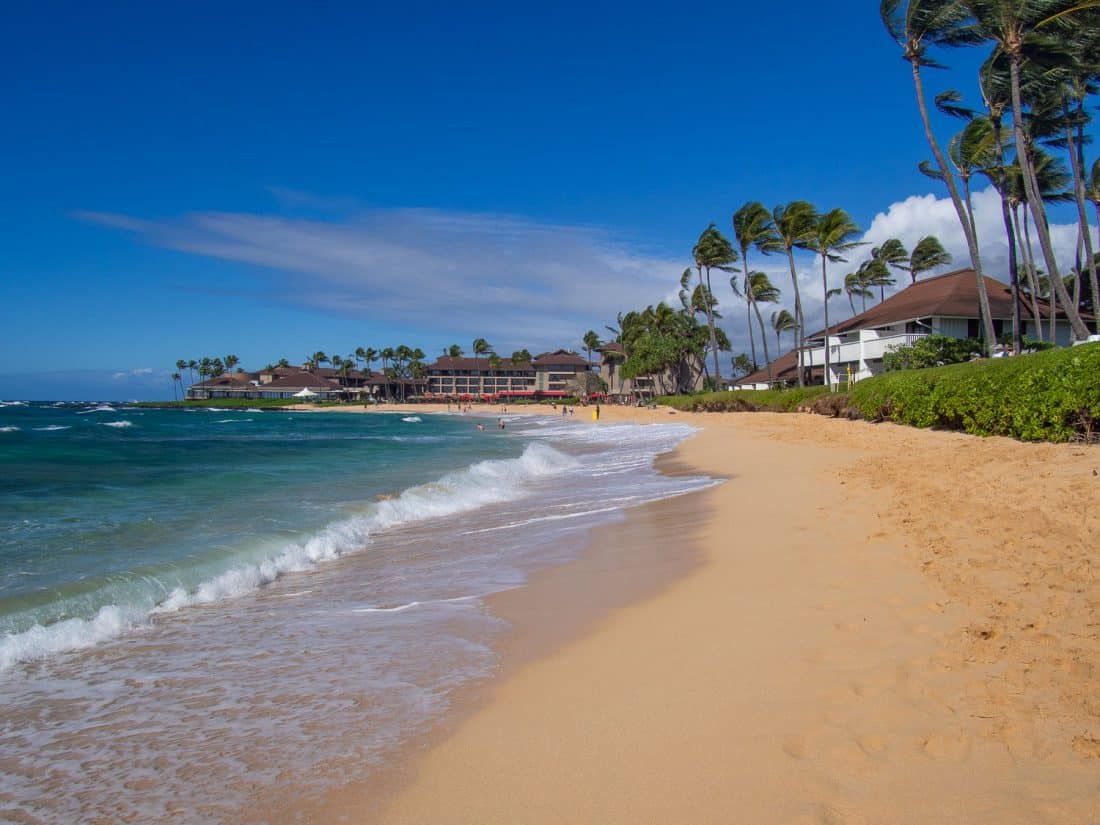
- Camp if you are on a tight budget – It’s not for everyone, but if you don’t mind roughing it, camping is the cheapest way to experience Hawaii. There are some beautiful campsites at beaches and state parks, although you usually need to get permits in advance. See this guide to camping in Hawaii for more tips.
- Search on Kiwi or Skyscanner for the best flight deals – You need to get on a plane to reach Hawaii. The cheapest rates will be from Los Angeles or other West Coast USA cities. Southwest now flies to Hawaii at low rates. You can also get affordable flights from Canada and Japan to Honolulu.
- Fly in and out of different islands – Maximise your time on the islands by flying into one island (such as Kauai) and out of another (such as Maui). I was surprised by how many affordable direct flights there are from the US mainland to places other than Honolulu.
- Rent a car – It’s the best way to see Hawaii and often there’s no other way to reach parts of the islands. At busy times rental cars can run out, so book far in advance. We use Booking.com Car Rentals to find the best deal and just book the cheapest economy car.
- Travel between islands by plane – There are no ferries between islands (except from Maui to Lana’i) so you’ll need to hop on an interisland flight. Most are operated by Hawaiian Airlines and are affordable and short (20 to 50 minutes).
- Consider splitting your time between two or three locations on each island – If you want to do a lot of exploring, this will help avoid long drives to attractions. We’ve done this on all four main islands and it worked out well.
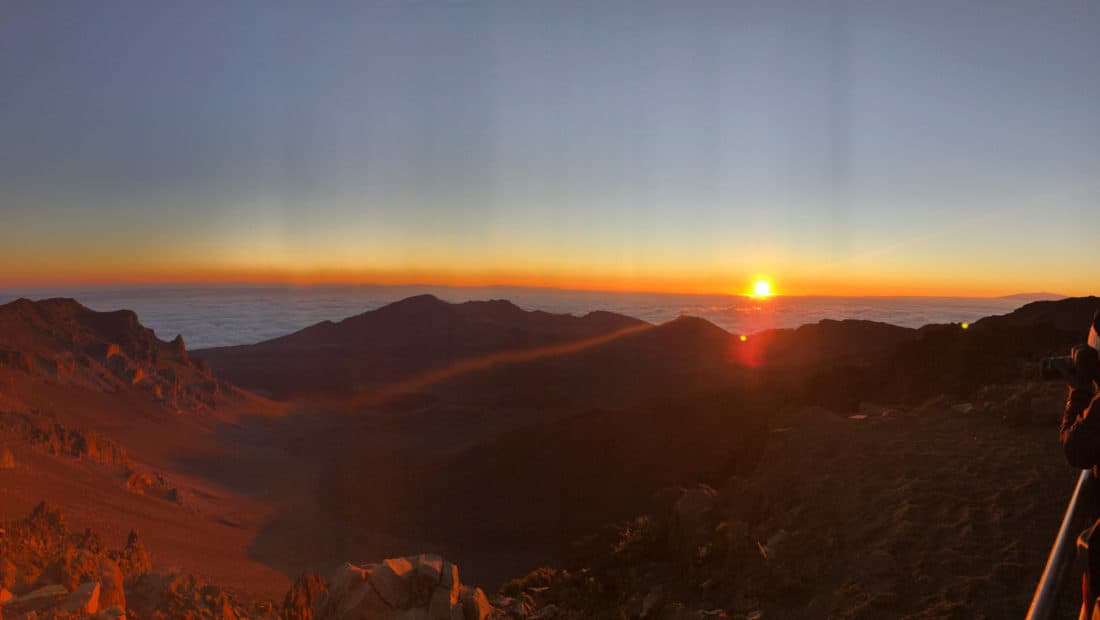
- Book Haleakala sunrise in advance – If you want to see Maui’s most popular sunrise, you must book up to 60 days in advance. If you miss out, try again two days before when more tickets are released.
- Make reservations for some state parks – Non-Hawaii residents need to book in advance for certain parks and pay an entrance and parking fee. These include Haena State Park in Kauai, Waianapanapa State Park on the Road to Hana in Maui, ‘Iao Valley in Maui, and Diamond Head in Oahu. Time slots are released 30 days in advance. Book as soon as possible as they do sell out.
- Pack a sweater – While most of the time you’ll only need summer clothes, it can get chilly on morning boat trips or if you go to higher elevations (like Upcountry in Maui or Waimea Canyon on Kauai) especially in the winter. Sunrise at Haleakala, Maui and sunset at Mauna Kea on the Big Island are freezing and you’ll appreciate as many layers as possible. See the end of this post for more tips on what to pack for Hawaii.
- Learn a few Hawaiian words – Even if it’s just Aloha (hello and goodbye but also love and compassion) and Mahalo (thank you). I picked up vocabulary by reading the astounding novel Shark Dialogues by Kiana Davenport (which I highly recommend every visitor reads).
- Book restaurants in advance – Upscale restaurants do fill up, so make reservations for anywhere you definitely want to eat (including at resorts). A few weeks in advance should be fine but places like Duke’s on Waikiki Beach book up months ahead. People tend to eat early in Hawaii (around 6pm) so it’s easier to get later reservations.
- Bring cash for tipping – While you can add a tip to your credit card in restaurants, it’s important to have cash for tour guides, valets, and resort staff. If you’re not American, familiarise yourself with tipping etiquette. We tipped 20% in restaurants and sit down bars, $10-20 per person for tours (including for helicopter pilots), $5 for valet attendants (when the car was returned), and around $2-3 a day for hotel housekeeping.
Don’t
- Plan to visit more than one island per week – You’ll spend too much of your precious Hawaii vacation time travelling and there’s so much to do on each island. While interisland flight times are short, airport security queues can be long (especially out of Honolulu) or flights delayed.
- Forget hidden fees – The listed price for hotels and resorts is rarely what you’ll actually pay. You’ll have to add tax and often a resort fee, cleaning fee (for condos), and parking charge. Check the final total price when comparing accommodation options.
- Visit during holidays – Try to avoid the busiest times of year, especially Christmas and New Year when crowds and prices soar. Thanksgiving week is another busy period. Avoid special events like Iron Man on the Big Island in October. If you must visit then, book far in advance.
- Stay on the beach (maybe) – If you are on a tight budget, you’ll save by staying a short walk or drive from the beach. That said, we often splurge on beachfront accommodation and love it.
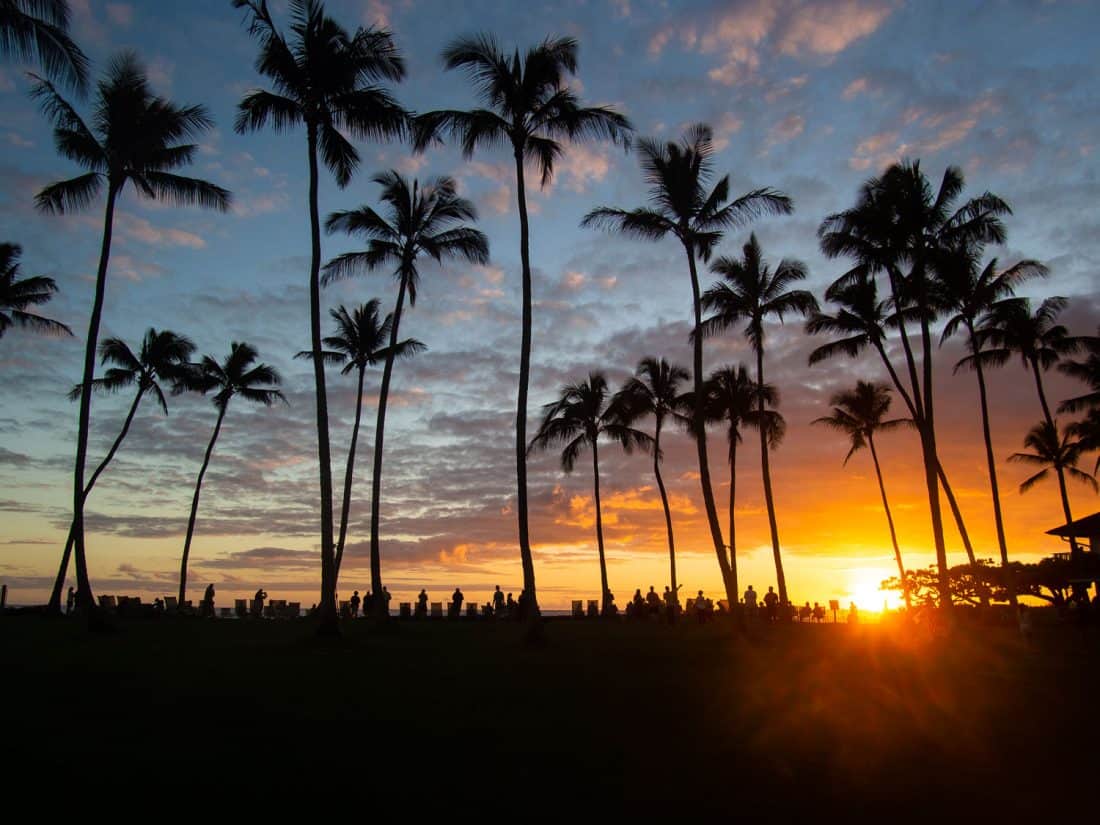
When You Are In Hawaii
Do
- Read novels set in Hawaii – Learn more about Hawaii’s fascinating culture and turbulent history by reading one of these books about Hawaii while you relax on the beach.
- Schedule your most important activities early – Weather can change and cancel activities like boat trips and helicopter rides, so make sure you’ll have time to reschedule.
- Book Hanauma Bay Nature Preserve on Oahu two days in advance – If you want to snorkel at this popular beach, you must make a reservation here at exactly 7am Hawaii Standard Time two days before your visit. Slots sell out in minutes. Tickets are $25. It’s closed on Mondays and Tuesdays.
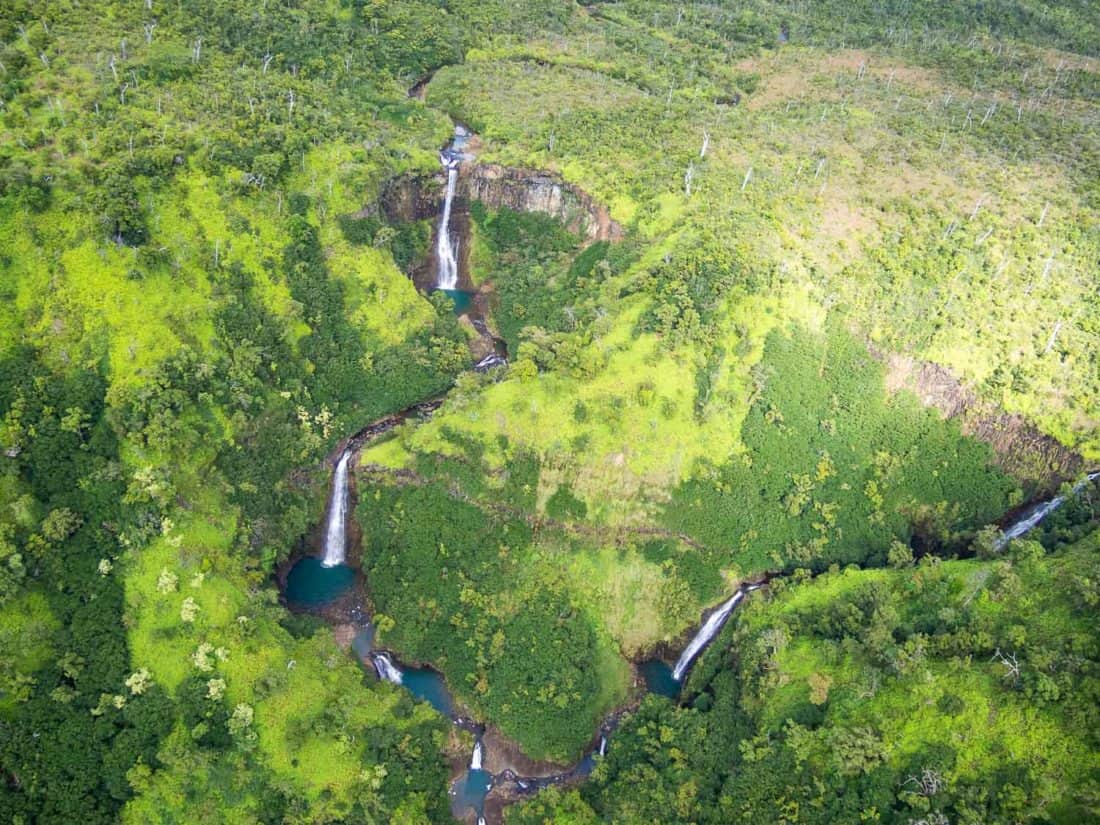
- Use reef-safe sunscreen – Hawaii has banned the sale of sunscreen that uses coral-harming chemicals (oxybenzone and octinoxate). You need a product that uses zinc oxide instead, like this Raw Elements sunscreen. Honestly, it’s a pain to apply, but it’s surprisingly water resistant, and it’s worth it to protect the reefs. Longs Drugs and ABC Stores are good places to pick up all your beach supplies on the islands.
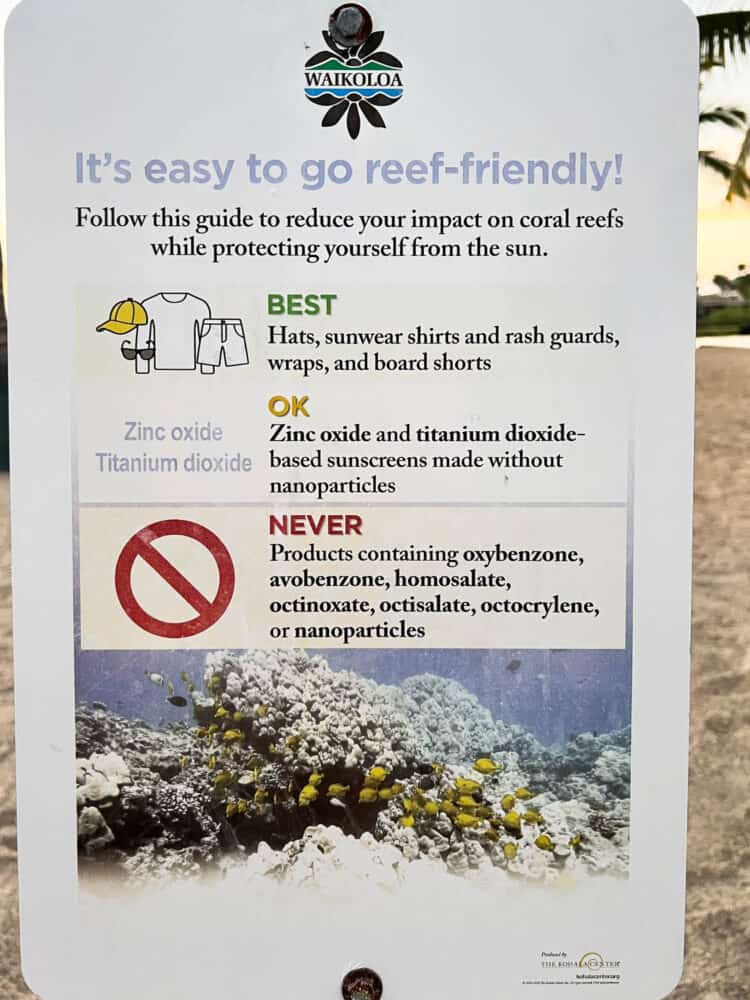
- Wear a rashguard – Even better than sunscreen is to protect your skin by wearing a rashguard in the water, especially when snorkelling.
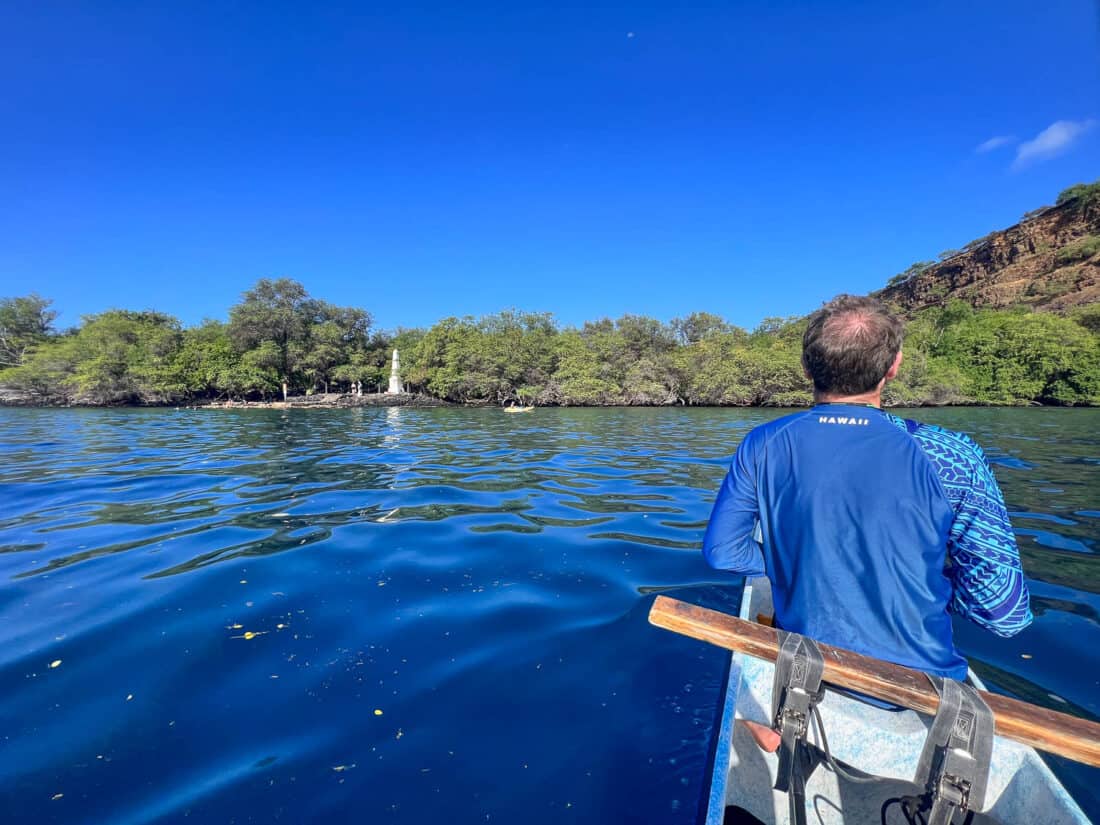
- Sign up to the Snorkel Report on Maui – You’ll get an email every morning with tips on the best beaches to visit that day. They also rent inexpensive snorkelling and beach gear.
- Check the Hawaii Beach Safety website – To find out which beaches are safe for swimming or best for surfing.
- Go whale watching – It was one of our favourite experiences in Hawaii. We chose a small boat trip with Makai Adventures from Lahaina in Maui and loved it so much we went twice. You can see whales on most of the islands—search for whale watching trips in Hawaii here.
- Hike – All the islands have beautiful trails from easy coastal walks to challenging multi-day treks. It’s a great free way to enjoy the beauty of the islands.
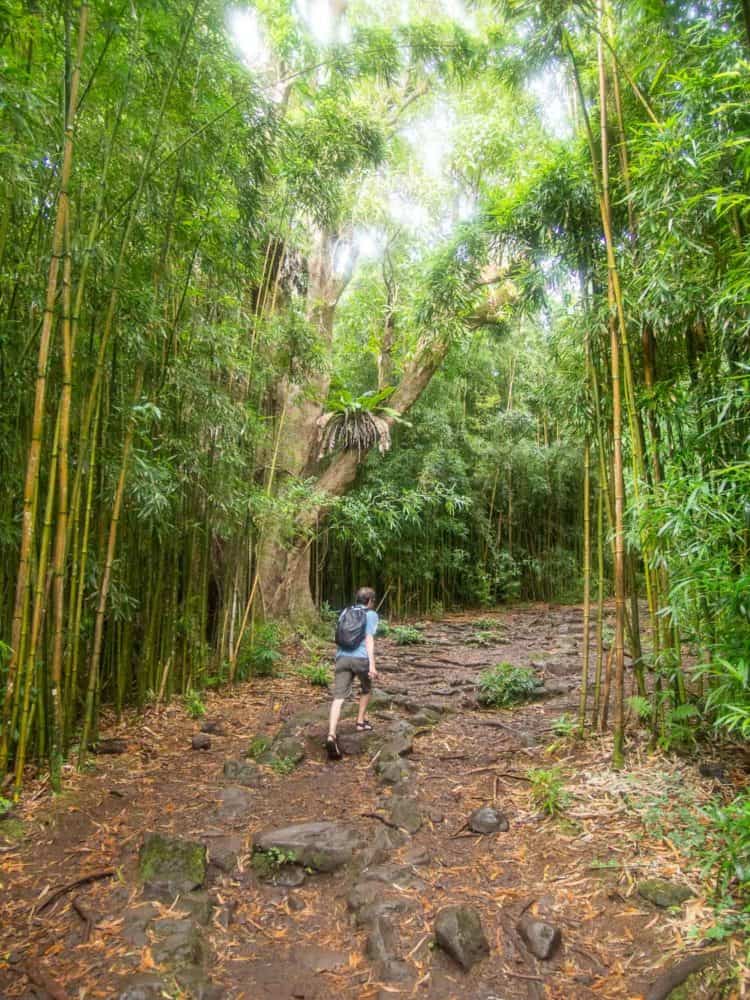
- Rent a Tommy Bahama beach chair and umbrella – Our condos came with these, but you can rent them on the islands inexpensively. They have backpack straps for easy carrying and make beach hopping much more comfortable.
- Bring or rent snorkel gear – If you have space in your luggage, bring your own snorkel and mask. If not, rent it for the length of your stay from a service like Snorkel Bob’s (as we did on the Big Island). I appreciated being able to take a look at the reef whenever we went to the beach.
- Visit a farmer’s market – The fresh produce is usually cheaper and better quality than the supermarkets and there are lots of tasty treats and foodie souvenirs to enjoy.
- Cool off with shave ice – This delicious icy treat is so much better than we expected. Add a scoop of macadamia ice cream on the bottom for maximum tastiness. Our favourites are Waikomo Shave Ice on Kauai and Original Big Island Shave Ice Co on the Big Island.
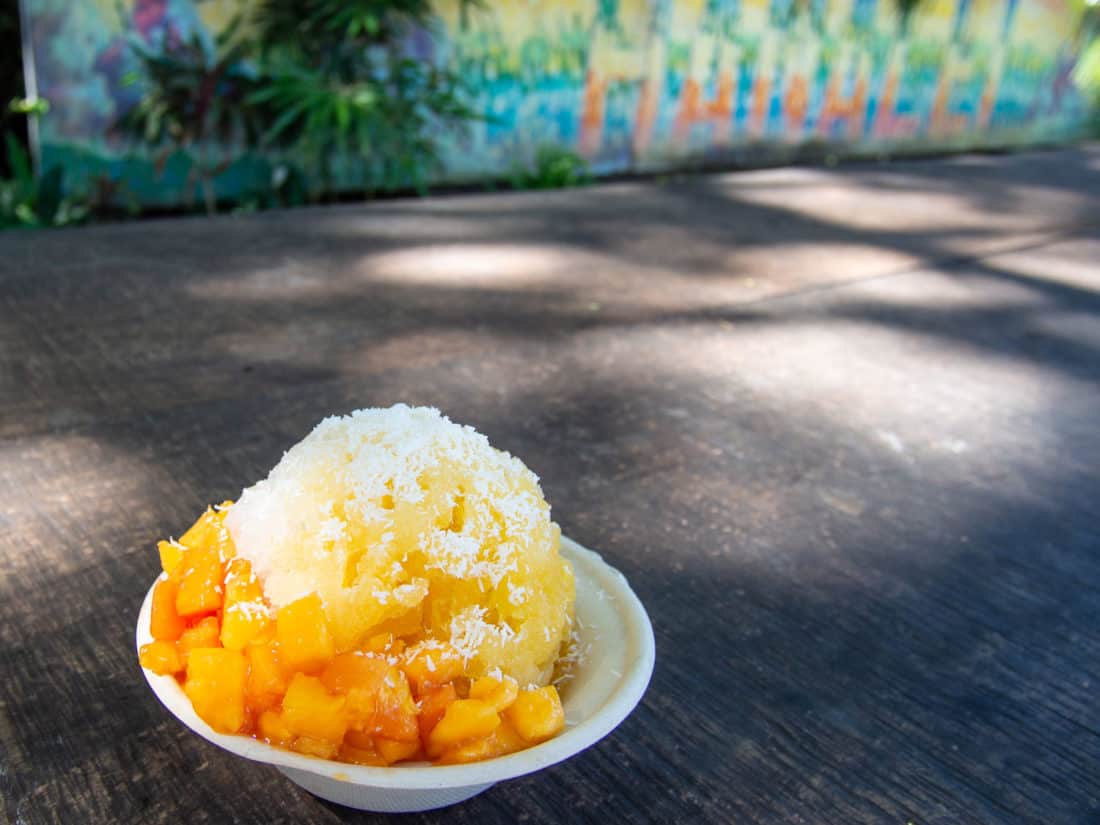
- Enjoy a Mai Tai on the beach – Touristy yes, but it’s a classic Hawaii experience and these tasty rum cocktails come in cool Tiki glasses.
- Try Li Hing Mui – This dried plum is sweet, salty, and sour. It’s very popular in Hawaii (originating from China), and you can find them whole for snacking (a bit much for me) or as a flavour for many treats. It’s my new favourite shave ice flavour (especially combined with lilikoi/passionfruit and pineapple).
- Drive the Road to Hana on Maui – Most people do this in one day, but we loved spending a few nights in Hana to explore without the crowds.
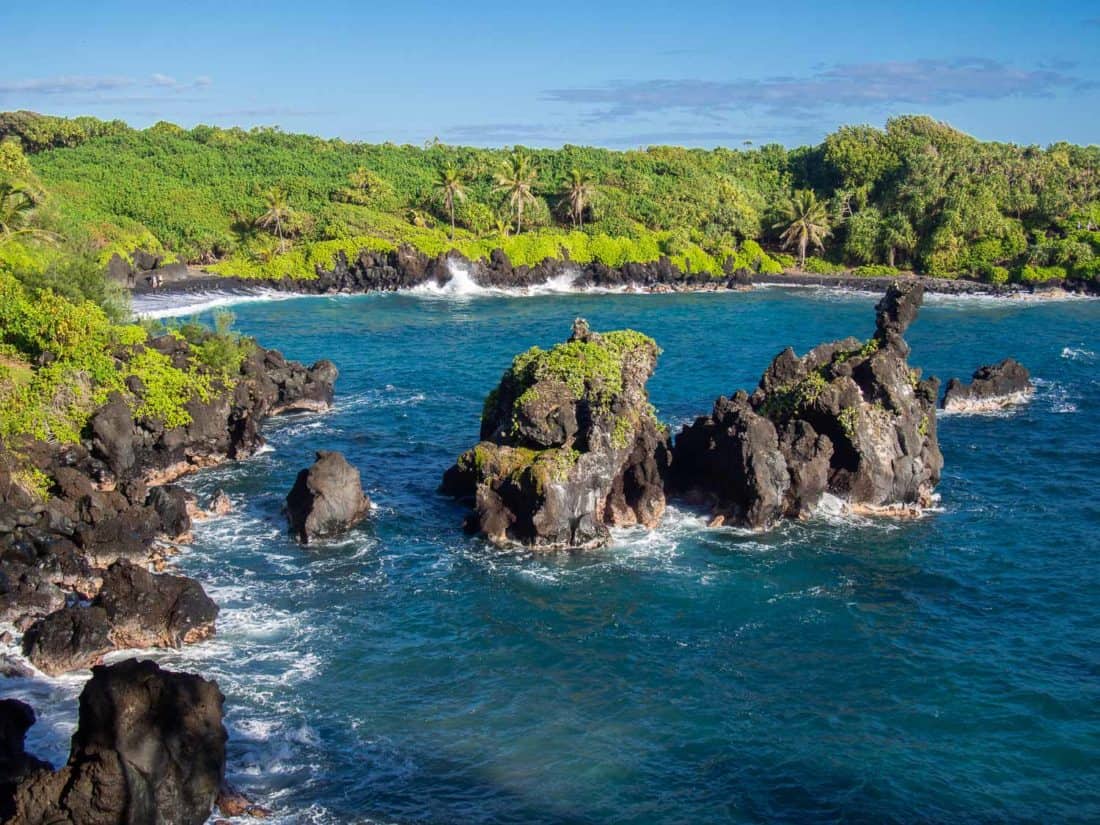
- Eat all the banana bread – Especially in the Hana area, homemade banana bread sold at farm stalls is so good.
- Indulge in chocolate-covered macadamia nuts – We were addicted to the ones by Moana Loa.
- Let local drivers pass you – They know the winding roads better than you and drive at a faster pace, so pull over and let them pass.
- See Kauai from above – Our doors-off helicopter trip on Kauai was mind-blowing and it’s the best island for a scenic flight. Our Oahu helicopter tour was also amazing. Search for scenic helicopter flights on other Hawaiian islands here.
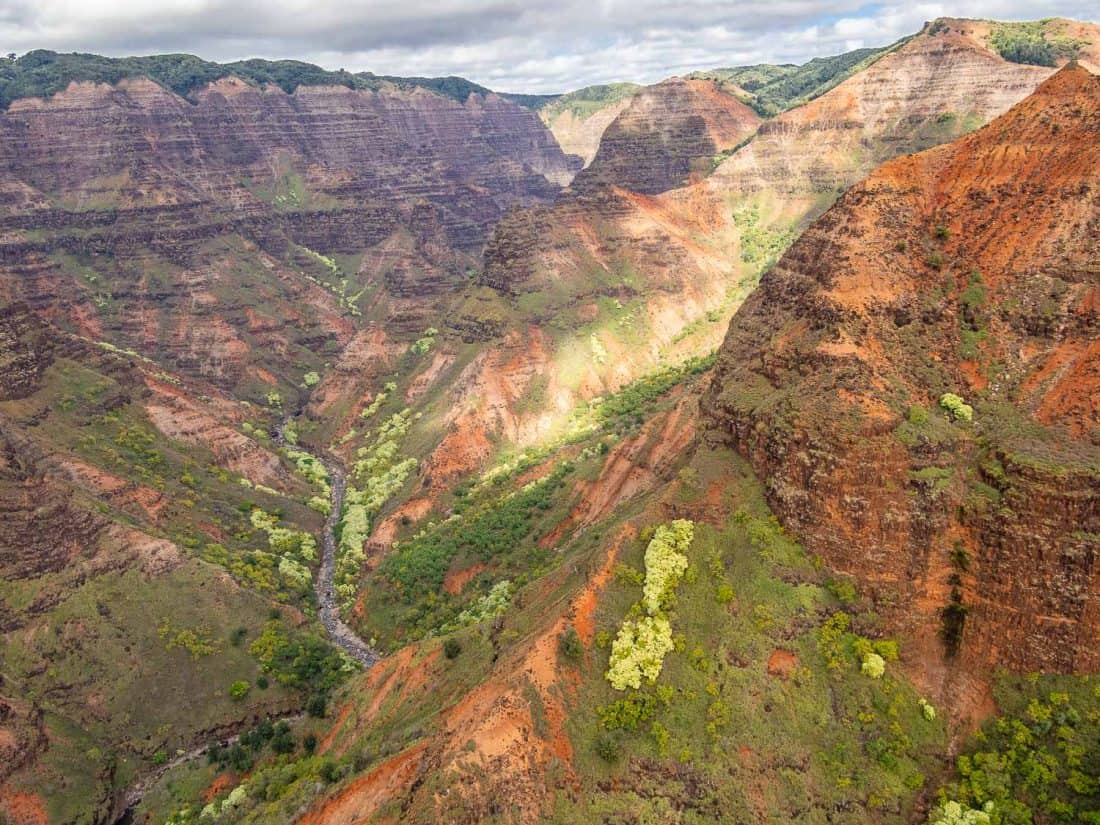
Don’t
- Eat in restaurants for every meal – Restaurants are expensive and by self-catering in our condo we saved a huge amount of money. Even if you don’t have a kitchen, you can pick up a pre-made picnic lunch from a supermarket and enjoy it on the beach. Some of our tastiest meals were from food trucks which are far cheaper than restaurants. Hana in Maui and Hanalei in Kauai had the best selection of trucks.
- Underestimate the ocean – Conditions can be dangerous and change quickly and drownings do happen. If you’re not sure it’s safe, don’t swim.
- Turn your back on the ocean – Huge waves can come out of nowhere when you are swimming or even walking along the shore.
- Fight a rip current – If you get caught in a current, keep calm, float, and wave for help. Go with the current and conserve your energy.
- Touch sea turtles or monk seals – You are likely to come across wildlife on the beaches, but it’s illegal to get too close or touch them.
- Feed fish or other wild animals.
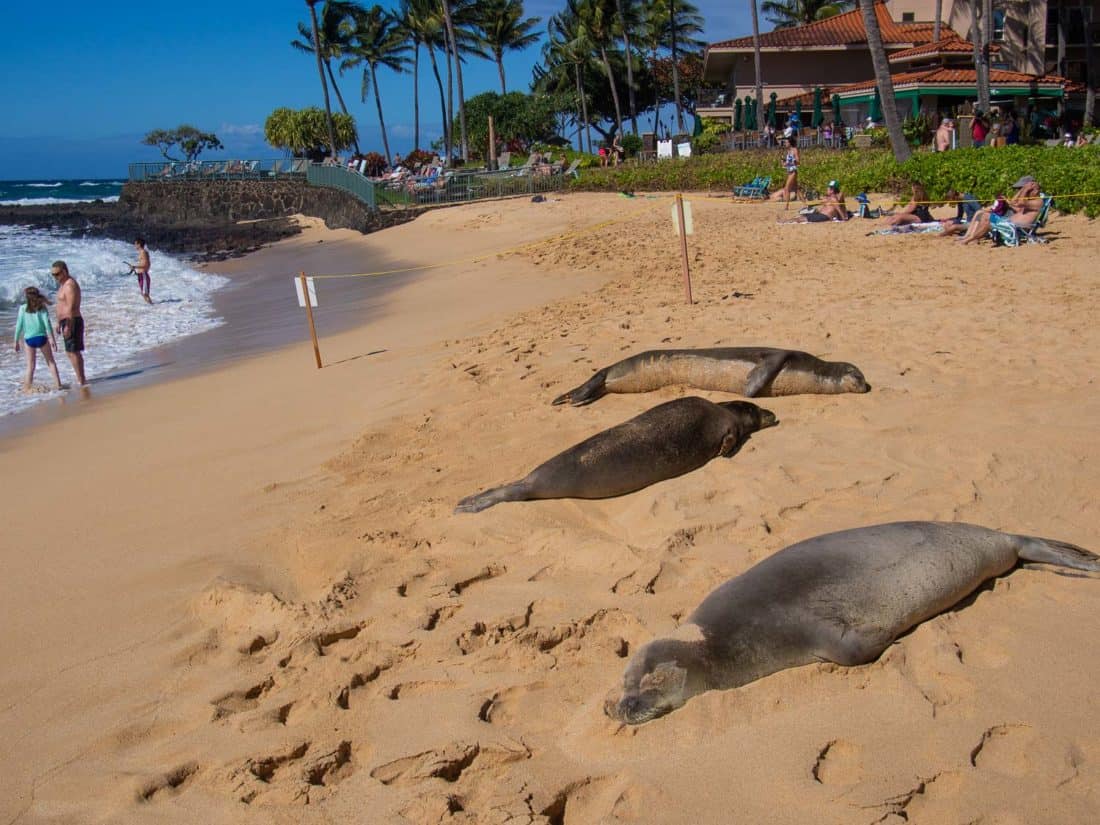
- Trespass – Please respect private property. While all beaches are open to the public, they don’t all have public access routes.
- Litter – Don’t leave anything behind on beaches or hiking trails.
- Park illegally – Respect “no parking” signs and don’t stop on the side of the road. This has become a real problem on the Road to Hana in Maui in particular.
- Steal any rocks or sand.
- Touch or step on coral – Be mindful of where your fins are when snorkelling.
- Leave valuables in your car – And keep any luggage hidden out of sight in the trunk. Rent a mid-size car rather than a compact one (we found these didn’t have an enclosed trunk).
- Laugh at the hula – It’s not just a dance for tourists, but a serious part of local culture.
- Refuse a lei (flower garland) – It’s a symbol of affection and Aloha so wear it with gratitude and don’t take it off in front of the person who gave it to you.
- Wear shoes into someone’s house.
- Rush – Don’t feel the pressure to do everything. Make sure you allow time just to relax by the pool or on the beach. Slow down and enjoy these beautiful islands.
Hawaii Tips for International Visitors
Visas
If you are flying direct to Hawaii from abroad, make sure you apply for an ESTA visa waiver before you arrive. I would do this as soon as you book your trip in case there are any issues and you have to apply for a visa at a US embassy or consulate (which can take months).
Note that if you have travelled to Cuba since January 12, 2021, you can not apply for an ESTA.
Mobile Passport Control App
Save time on arrival at Honolulu Airport by downloading the Mobile Passport Control App if you are entering with an ESTA.
You can fill in your details and upload documents on the app and gain access to a different, shorter line at immigration.
We haven’t used this in Hawaii yet but it worked well for us in Orlando. We had to ask which line to use at the airport and got to use the diplomats line with no wait.
International SIM Card
We used to buy a T-Mobile SIM card when we visited the US, but we now prefer to use digital Airalo e-SIMs. They are affordable and mean we don’t have to change the physical SIM in our phone.
The only downside is not getting a local phone number.
What to Pack for Hawaii
Clothes
The weather is warm year-round in Hawaii so pack lightweight summer clothes—shorts, t-shirts, dresses, a couple of bathing suits, and a beach cover-up.
I’m a big fan of PrAna for summer dresses and swimwear.
There’s no need to pack formal clothes as Hawaii is very casual.
I do recommend packing one set of warmer clothes for visiting places at higher elevations or boat trips in winter. A pair of jeans or leggings plus a lightweight fleece or sweater should be fine.
If you are planning on sunrise at Haleakala in Maui or stargazing at Mauna Kea on the Big Island, it can be freezing, so add more layers and perhaps a packable down jacket if you have one (I like the Patagonia Nano Puff Hoody).
Shoes
We spend most of our time in Hawaii wearing hiking sandals—they are perfect for beaches and hikes. Many beaches have rough access trails so you’ll appreciate something more than flip-flops.
We both love Teva sandals which are very comfortable for hiking and most models are waterproof so are great for kayaking. Simon likes the Teva Fi Lite sandals and I have the Teva Verra sandals.
I also had a pair of ballet flats for a dressier option for the evenings. My current favourites are the super comfy Allbirds Tree Breezers—see my Allbirds flats review for details.
For running, I wear the light, breathable Allbirds Tree Dashers.
Other Useful Items
- Reef-safe sunscreen – Avoid sunscreens containing oxybenzone and octinoxate which have been banned in Hawaii.
- Reusable shopping bags – Plastic bags are banned on the islands.
- Spices – If you are self-catering, you’ll save money by bringing a small amount of spices with you. We bought some at the bulk-buy section of a supermarket on the mainland.
- Water bottle – Avoid creating plastic waste by packing a reusable water bottle. We like the Vapur water bottle as it’s light and packs flat when empty.
- Packable daypack – These backpacks fit in your luggage on the trip over and are useful for hikes and exploring.
- Packing cubes – We swear by these as they keep your clothes organised and easy to find in your luggage.
- Quick-dry beach towel – These lightweight towels dry faster than traditional towels and sand shakes off them more easily.
- Compact binoculars – There’s so much wildlife to see in Hawaii including whales, dolphins, seals, turtles, and birds. The tiny Olympus 8 x 21 RCII waterproof binoculars were ideal for getting a closer look.
Is Hawaii Worth it?
Yes, I think Hawaii is well worth visiting! While it is expensive and can be crowded, there’s something about that stunning scenery and relaxing vibe that entices many of us to visit again and again.
I hope this blog post helps you with how to plan a trip to Hawaii. Let me know if you have any questions and share your Hawaii travel tips in the comments below.
More Hawaii Posts
We share more of our Hawaii tips in these posts:
Oahu
Maui
- 25 Best Things to Do in Maui
- The Ultimate Maui Itinerary: The Best of Maui in 7 to 14 Days
- 17 Stunning Road to Hana Stops & Why You Should Stay in Hana, Maui
Kauai
- Where to Stay in Kauai: The Best Areas and Hotels
- 17 Unmissable Things to Do in Kauai
- A Doors Off Helicopter Tour on Kauai: Is It Worth it?
- 14 Best Beaches in Kauai
Big Island
General
Enjoyed this post? Pin it!
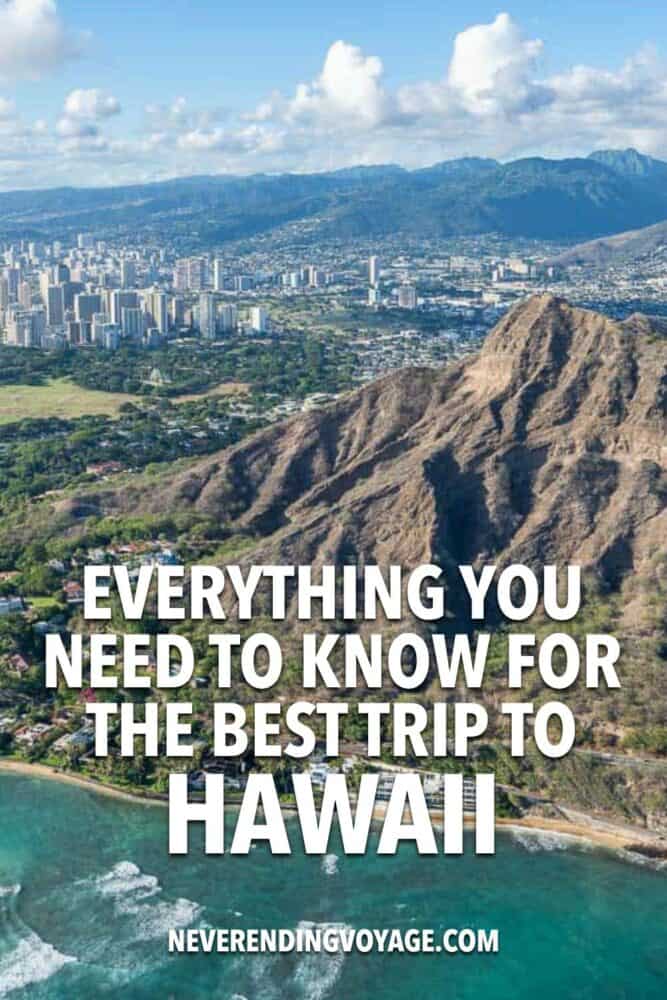
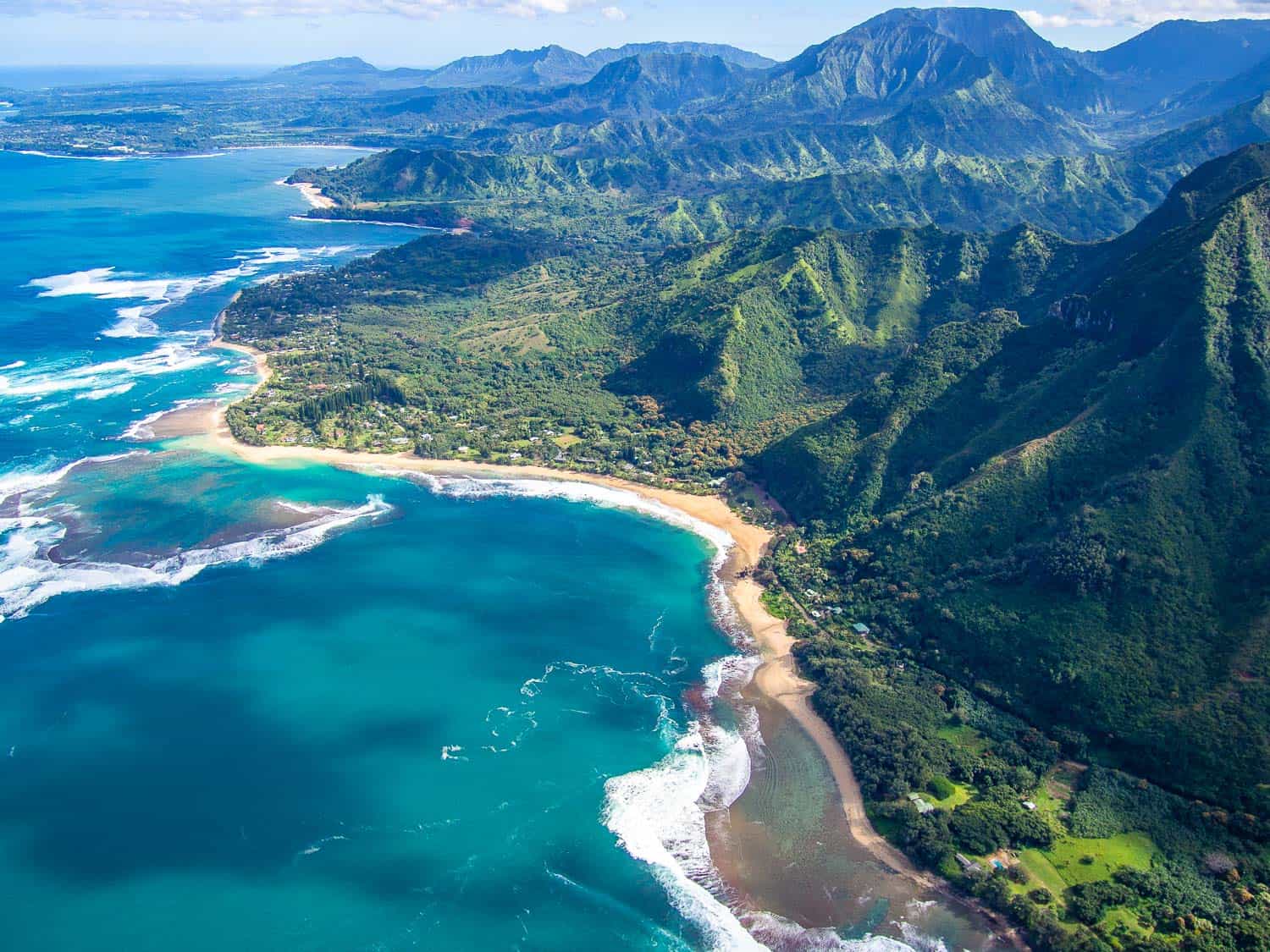
I’m wondering if one must rent a car to travel? Is uber not available in Hawaii?
It depends where you go. It Honolulu on Oahu you could manage without a car as there is Uber and you could also take the bus or tours to some attractions.
In other places it would be challenging as Uber is limited and attractions are spread apart. If you wanted a relaxing vacation spent mostly in your resort you could manage without a car and just take a few tours. But to see a lot, a car gives you the most flexibility.
Your review made no mention of exploring the art museum & palace.
These 2 spots are essential visits in Oahu. Exploring how Hawaiian islands last provincial part of royal hawaiian culture just before annexation to the United States as a territory, and later a state is fascinating. The art museum and also Duke Mansion have extremely rare & valuable originals of some of the most revered artists in varying mediums. Picasso, Monet, Rembrant, Matisse, Van gough, O’keife. Really disappointing it is not even mentioned here. I have visited Hawaiian Island more than 10 + times. They are essential stops.
Thanks for the suggestions, Susanne. Everyone has different priorities, and for us, with limited time in Honolulu, we preferred to focus on the amazing outdoor attractions.
I do think it’s important to learn about Hawaii’s history and culture so I’ve read a lot of books about it.
This is so helpful and thorough! I have been clicking back and forth to different articles. Thank you for putting your time in to such a great resource.
I’m glad you found it useful! Thanks Jennifer for the kind words!
Hi!! Do you have any recommendations on phone/data plans for internationals?💕
We’re currently in the US and are using T Mobile. Simon got an unlimited data plan for $50 a month and bought the SIM in advance from SIM Corner while we were in New Zealand (they ship from various countries).
That was useful as it meant we had the SIM as soon as we arrived (most airports don’t seem to have places to buy SIMs).
I just went into a T-Mobile shop to buy mine and got the cheapest plan of $15 for 2.5GB data valid for 30 days. Plus $10 for the SIM card. All plans have unlimited domestic talk and text.
If you look in the trucks at Farmers Markets….many of the boxes are from COSTCO. If you plan to self-cater, shop at COSTCO first and then Walmart if the island your visiting has one.
Do you know if the Covid restrictions would prevent people from renting a car and doing their own circle tour. These tours are outrageously expensive for only 15 mins at each location. I could easily just use our rental car and take our time seeing what we want to see. So my question is will the State of Hawaii only allow these pricey tours right now because of Covid? For example, I don’t want to drive to see the Halona Blowhole only to find out we can’t get near it because of certain restrictions.
You are allowed to rent a car (as long as you don’t have to quarantine which you shouldn’t if you get a test before arrival) so there’s no reason not to drive yourself. There is high demand for car rentals in Hawaii at the moment (many rental companies sold off cars last year) so book as far in advance as possible.
Hi! Thank you for this article it was very helpful. For the sunrise mountain in Maui, I saw the reservations is per car. Do you drive all the way up or hike? I will be traveling with some older people (70+), so trying to understand the feasibility? Thank you!
Yes, it is per car. You drive all the way up and don’t have to walk more than a few minutes from the carpark to the viewpoint. There are optional hiking trails around for post-sunrise, but it’s still stunning without any walking.
Thank you for the tips to “Bring reusable shopping bags” and “Schedule your most important activities early”. Very good points to keep in mind.
I love that Hawaii has so many places that offer to rent (folding) beach chairs! I find that option sorely missing from the islands in the Caribbean. In fact, I ended up buying an inexpensive beach chair from Wal-mart when we were in Puerto Rico this past winter.
What about tent camping, is that not a viable alternative to the high priced lodging?
Tom
Yes, that’s definitely the cheapest way to experience Hawaii. It’s not our thing, although we saw the campsite at Waianapanapa State Park on Maui and you can’t beat the location!
I’ve lived on Kauai for over 40 years. While I agree with nearly everything you say in this excellent article, there was one glaring error that any Kauai resident could confirm. Although visiting off season is, indeed, (somewhat) cheaper and certainly less crowded, the weather in April on Kauai (and generally March) is far from excellent. Many, many visitors to Kauai have had their vacations ruined by our relentless April rains (in fact, much of the north shore is still closed from catastrophic rains over a year ago, and a couple of years before that it rained for nearly 40 straight days (okay, maybe not, but any local will swear by it…). April is by far the worst possible month to visit Kauai and it does your readers a digs-service to urge them to do so.
Thanks for the information Bill. I will update the post.